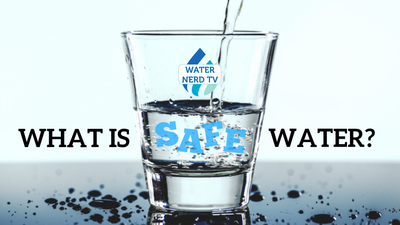Stephanie Angione, Ph.D. | Scientific Contributor
Editor's Note: In this week's article, Dr. Angione tackles one of the biggest pseudoscience topics in the water industry: ionized/alkaline water. We wrote this article because alkaline water generators cost thousands of dollars and provide no measurable benefit to users.
What Is Alkaline Or Ionized Alkaline Water?
By definition, alkaline water is water that has a pH greater than 7. This can occur naturally in water sources when dissolved minerals like calcium, potassium, magnesium, silica and bicarbonate are present. This type of naturally occurring alkaline water is generally referred to as mineral water. Other bottled sources of alkaline water have substances like bicarbonate added, increasing the overall pH and alkalinity of the water.
However, certain water ionizer machines claim to create alkaline water by separating tap water into acidic and alkaline water streams through electrolysis. The manufacturers of such machines (and their affiliates) have made many health claims, which are not backed by any conclusive clinical trials of ionized alkaline water. Whenever an article says "studies showed that..." you'll want to take a close look at the study. We'll be doing this in a series of follow up blog posts.
How Does A Water Ionizer Claim To Work?
The water ionizers on the market claim to create alkaline water through electrolysis. The idea is that water is split to form hydrogen and oxygen by an electric current, so that water near the anode is acidic and water near the cathode is alkaline. The idea is that you can then siphon off acidic or alkaline water using a tube next to the cathode or anode.
Here's the problem: That's not really what's happening. Pure water or water with relatively low mineral content conducts electricity very poorly, so it can't undergo electrolysis to any significant extent.
To get around this, water ionizers use “enhancement solutions” which essentially allow the user to add salt to increase the conductivity of the water and thus make the “strongest ionized water” with the device. When a solution of sodium chloride undergoes electrolysis, sodium hydroxide (dilute drain cleaner) is created at the cathode, which can be drawn off as “alkaline water.” At the anode, chlorine builds up and if it is combined with hydroxide ions at the cathode, creating a hypochlorous acid, the protonated form of laundry bleach. A water ionizer is essentially a very expensive way to create dilute solutions of household chemicals.
What Does Ionized Alkaline Water Claim To Do?
Is ionized alkaline water healthy? Manufacturers of ionizers and alkaline water claim that it neutralizes acid in the blood and throughout the cells and organs in the body, which prevents all forms of diseases including cancer. This is completely bogus because...
How Does Alkaline Water Consumption Alter Blood pH?
It doesn’t. The human body has a highly effective buffering system to maintain blood pH between the ranges of 7.35 and 7.45. Severe medical conditions occur when the blood pH drops below 7.35, called acidosis, which is usually a result of metabolic, kidney or respiratory problems. Additionally, if the blood pH is too high, the resulting medical condition is alkalosis, which can also be the result of respiratory disease, or when concentration of minerals in the body are too low. The bottom line is that in healthy people, whenever the acid-base balance in the blood is off, the body will regulate it through the respiratory and renal systems.
The buffering system in the body also maintains the acid-alkaline balance in each of the organ systems- for example the stomach is much more acidic than any other system, with a pH around 2. The fact remains that our blood pH is fairly constant and is not affected by what we eat or drink. If our bodies were affected by consumption of acidic and basic foods so readily, our blood pH would be constantly changing, causing all types of unpleasant physiological symptoms!
Additionally, while alkaline water created from water ionizers may have a higher pH than tap water, it has low alkalinity, or low ability to neutralize acid. To think of it in a slightly more approachable way... alkaline water's impact on your stomach's pH is comparable to the cooling effect of putting a drop of room temperature water into a large pot of boiling water.
What’s The Bottom Line On Ionized Alkaline Water?
The claims of health benefits of alkaline water are bogus and manufacturers of water ionizers are peddling high priced pseudoscience (remember... pseudo means sham/fake). And here at Hydroviv, we are dedicated to debunking pseudoscience to protect both you and your family.
If you are concerned about the quality of your water at home, it is best to get a water filtration system that can remove contaminants from your drinking water.
Do You Have More Questions?
Hydroviv makes it our business to help you better understand your water. As always, feel free to take advantage of our “help no matter what” approach to technical support! Our water nerds will work to answer your questions, even if you have no intention of purchasing one of our water filters. Reach out by dropping us an email (hello@hydroviv.com) or through our live chat.







